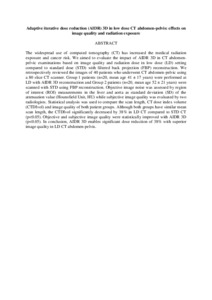Citation
Ang, Wee Chin and Hashim, S. and Abdul Karim, Muhammad Khalis and Bahruddin, N. A. and Salehhon, N. and Musa, Y.
(2017)
Adaptive iterative dose reduction (AIDR) 3D in low dose CT abdomen-pelvis: effects on image quality and radiation exposure.
Journal of Physics: Conference Series, 851.
pp. 1-6.
ISSN 1742-6588; ESSN: 1742-6596
Abstract
The widespread use of computed tomography (CT) has increased the medical radiation exposure and cancer risk. We aimed to evaluate the impact of AIDR 3D in CT abdomen-pelvic examinations based on image quality and radiation dose in low dose (LD) setting compared to standard dose (STD) with filtered back projection (FBP) reconstruction. We retrospectively reviewed the images of 40 patients who underwent CT abdomen-pelvic using a 80 slice CT scanner. Group 1 patients (n=20, mean age 41 ± 17 years) were performed at LD with AIDR 3D reconstruction and Group 2 patients (n=20, mean age 52 ± 21 years) were scanned with STD using FBP reconstruction. Objective image noise was assessed by region of interest (ROI) measurements in the liver and aorta as standard deviation (SD) of the attenuation value (Hounsfield Unit, HU) while subjective image quality was evaluated by two radiologists. Statistical analysis was used to compare the scan length, CT dose index volume (CTDIvol) and image quality of both patient groups. Although both groups have similar mean scan length, the CTDIvol significantly decreased by 38% in LD CT compared to STD CT (p<0.05). Objective and subjective image quality were statistically improved with AIDR 3D (p<0.05). In conclusion, AIDR 3D enables significant dose reduction of 38% with superior image quality in LD CT abdomen-pelvis.
Download File
![[img]](http://psasir.upm.edu.my/60771/1.hassmallThumbnailVersion/Adaptive%20iterative%20dose%20reduction%20%28AIDR%29%203D%20in%20low%20dose%20CT%20abdomen-pelvis%20effects%20on%20image%20quality%20and%20radiation%20exposure.pdf)  Preview |
|
Text (Abstract)
Adaptive iterative dose reduction (AIDR) 3D in low dose CT abdomen-pelvis effects on image quality and radiation exposure.pdf
Download (5kB)
| Preview
|
|
Additional Metadata
Actions (login required)
 |
View Item |

